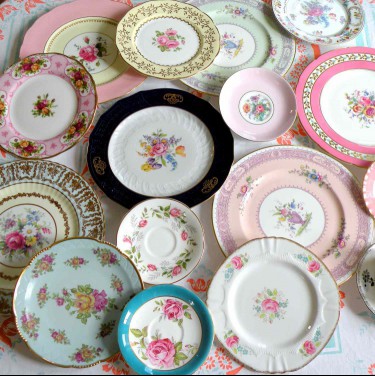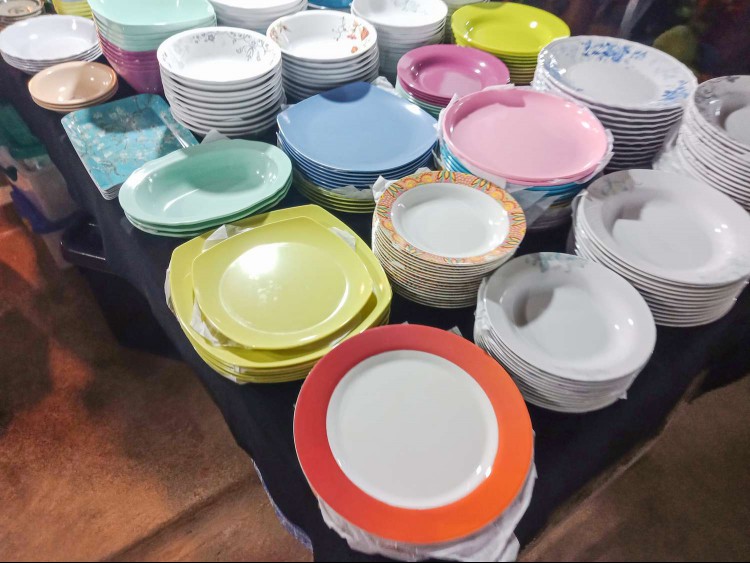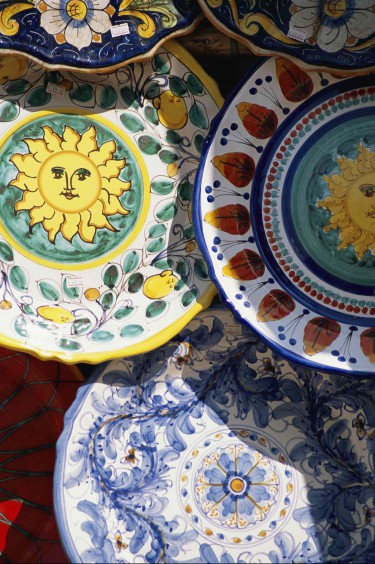If you’re frequently hosting dinners and get-togethers at home, then chances are you'll obsess over tablescapes—from the dinnerware to the linens—almost as much as your home decor and furniture.
"Dishware trends have had their fair share of ‘it’ moments over the years, and just like in fashion, some styles don’t age as gracefully as others,'” says Isabel Byrnes, founder and principal designer of Byrnes Design Studio NY.
We asked interior designers and a professional event planner to point out which once popular dishware is out of style today to help you avoid killing the mood at your next dinner party. They also chime in on suitable alternatives.
Meet the Expert
- Isabel Byrnes is the founder and principal designer of Byrnes Design Studio NY.
- Cintia Dixon is founder and CEO of Tlina Design and the president of the ASID New York Metro chapter.
- Courtney Lutkus is an event planner and designer, and the owner of Simply Radiant Events.
Ornate China With Gold Rims

highteaforalice.com / Getty Images
Heavy and ornate China with gold rims was particularly big for weddings and anniversaries, but now they feel overly formal and dated, according to Courtney Lutkus, owner of Simply Radiant Events. Even the more minimal versions of this style (such as plain white or ivory with gold rims) have fallen out of favor.
“They were practically a staple on every formal dining table in the ’80s and ’90s but are now more likely to pop up in a vintage shop than in a modern home,” says Byrnes.
There are many iterations of the China with gold rims, but she specifically singles out the pastel floral variety as old-school. Instead, try artisanal, handmade designs in neutral, earthy tones. Pieces with matte finishes, reactive glazes, and soft, muted color palettes feel fresh and enduring, making them easy to mix, layer, and customize, she adds.
“The result is a table that looks elevated for everyday living yet still feels personal, collected, and effortlessly stylish," says Byrnes
Want more design inspiration? Sign up for our free daily newsletter for the latest decor ideas, designer tips, and more!
Bulky Brown Stoneware
Picture the chunky, deep-brown or brown-speckled stoneware plates and bowls of the 1970s and ’80s that were popular because they gave off a cozy, home-cooked meal look.
“They were sensible then, but they can be visually heavy on the table today,” says Cintia Dixon, founder and CEO of Tlina Design.
If you want dishes with a similar feel but up to date, she recommends going with matte stoneware in neutral shades such as warm white, sand, and charcoal.
Bright Colored and Mismatched Melamine

Mojoje / Getty Images
That firm plastic dinnerware introduced in the 50s to the American market, melamine plates and trays were often presented in solid vibrant colors, a mix of color and printed pattern, or with printed designs, some of which attempted to mimic ceramic plate styles.
Bright and mismatched melamine was a common sight in casual backyard parties years ago, but it’s not fit for modern entertaining, says Lutkus.
Dixon seconds this: “Multicolor melamine was perfect for a summer picnic in the ’90s, but it’s not suitable for a sophisticated dinner table.”
That’s not to say, however, that you have to nix melamine altogether for your outdoor barbecues, dinners, or rambunctious children’s parties. Look for more minimalist melamine dinnerware collections that are offered in muted and earthy on-trend colors. These boast the affordability, durability, and light weight of the older melamine styles but are visually more in tune with modern tablescapes.
Hand-Painted Tuscan Ceramic Dinnerware

Michelle Garrett / Getty Images
Meant to offer a rustic look, these ceramics were mostly popular in the late ’90s and typically had a hand-painted border, sometimes encircling a painted countryside scene but more often a mélange of flourishes with natural motifs (leafy vines, fruit, flora, vegetables, etc.).
“They were once the height of ‘European chic,’ but they’ve stepped aside for a new wave of tabletop style,” says Byrnes.
If you still long for something that looks less mass-produced, forego the busy painted artwork and look at solid-color handmade ceramics. Subtle variations in glaze or form produce a one-of-a-kind handmade character for each piece, says Dixon.
Plain Glossy White and Round Plates
This is highly debatable even among our experts. Dixon is pro classic white porcelain, saying “it’s the ultimate blank canvas: You can dress it up or keep it simple.”
If you’re looking to add color, however, she cites blush, soft green, and muted blue as good options, as these can inject personality without overwhelming the table.
On the other side, Lutkus says that plain glossy white round plates might be timeless in some settings, but they can look flat and uninspired. She recommends textured or handmade-look ceramics to add dimension. And try mixing materials (such as pairing ceramic plates with wood chargers, slate boards, or rattan placemats) to create a curated, collected look.
